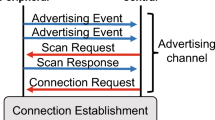Abstract
An energy efficiency optimization model for the IEEE 802.15.6 standard based wireless body area network is described in this paper. Cross-layer approach has been used here by focusing on physical (PHY) and medium access control (MAC) layers taking into account relevant characteristics therein. Studied PHY is based on impulse radio ultra wideband (IR-UWB) signaling with mandatory on–off keying modulation and non-coherent energy detection receiver. The analyzed MAC protocol is slotted Aloha which is used in the contention based mode of the IEEE 802.15.6 std. using IR-UWB PHY. The proposed model can be used to compare the energy efficiency of uncoded and coded transmissions using different Bose–Chaudhuri–Hocquenghem code rates. The model enables joint code rate and packet length optimization in AWGN channel when using the path loss model for hospital scenario, defined by the IEEE P802.15 working group. Results clearly show the most energy efficient code rate and packet length as a function of distance.

















Similar content being viewed by others
References
Biard, L., & Noguet, D. (2008). Reed–Solomon codes for low power communications. Journal of Communications, 3(2), 13–21.
Boulis, A., Smith, D., Miniutti, D., Libman, L., & Tselishchev, Y. (2012). Challenges in body area networks for healthcare: The MAC. IEEE Communications Magazine, 50(5), 100–106.
Cheng, L., Jiao, W., Chen, M., Chen, C., & Ma, J. (2013). Wait, focus and spray: Efficient data delivery in wireless sensor networks with ubiquitous mobile data collectors. Springer Telecommunication Systems Journal, 52(4), 2503–2517.
Dargie, W., Chao, X., & Denko, M. K. (2010). Modelling the energy cost of a fully operational wireless sensor network. Springer Telecommunication Systems Journal, 44(1–2), 3–15.
Desset, C., Fort, A. (2003). Selection of channel coding for low-power wireless systems. In: IEEE Vehicular Technology Conference (VTC).
Dotlic, I., Kohno, R. (2011). Preamble structure and synchronization for IEEE 802.15.6 impulse-radio ultra-wideband physical layer. In: International Symposium on Medical Information and Communication Technology (ISMICT).
Garcia, M., Sendra, S., Lloret, J., & Canovas, A. (2013). Saving energy and improving communications using cooperative group-based wireless sensor networks. Springer Telecommunication Systems Journal, 52(4), 2489–2502.
Goel, M., Shanbhag, N.R. (1999). Low power channel coding via dynamic reconfiguration. In: IEEE International Conference on Acoustic, Speech, and Signal Processing (ICASSP).
Hernandez, M., Kohno, R. (2011). UWB on–off waveform coded modulation for body area networks. In: IEEE International Conference on Ultra-Wideband (ICUWB).
IEEE P802.15 Working Group for WBANs: Channel Model for Body Area Network (BAN). Technical document, The Institute of Electrical and Electronics Engineers, Inc. (2009).
IEEE Std. 802.15.6: IEEE Standard for Local and metropolitan area networks—Part 15.6: Wireless Body Area Networks. Standard, The Institute of Electrical and Electronics Engineers, Inc. (2012).
Karvonen, H., Goratti, L. (2010). Optimal code rate for wireless sensor networks using IR-UWB and non-coherent detection. In: IEEE International Conference on Mobile Ad-hoc and Sensor Systems (MASS’10). San Francisco, CA.
Lin, S. D. C. (1983). Error control coding: Fundamentals and applications., Series in Computer Applications in Electrical Engineering Englewood Cliffs: Prentice-Hall.
Paso, T., Niemelä, V., Haapola, J., Iinatti, J. (2012). Novel modulation adaptation techniques for IEEE 802.15.4a UWB system. In: International Symposium on Medical Information and Communication Technology (ISMICT).
Pellenz, M. E., Souza, R. D., & Fonseca, M. S. P. (2010). Error control coding in wireless sensor networks: Trade-off between transmission and processing energy consumption. Springer Telecommunication Systems Journal, 44, 61–68.
Proakis, J. (2001). Digital communications (4th ed.). New York: Irwin / McGraw-Hill.
Rabbachin, A. (2008). Low complexity UWB receivers with ranging capabilities. In: Ph.D. Dissertation. Oulu University (2008). Available:http://herkules.oulu.fi/isbn9789514288005/isbn9789514288005.pdf.
Rashwand, S., Misic, J. (2011). Performance evaluation of IEEE 802.15.6 under non-saturation condition. In: IEEE Global Communications Conference (GLOBECOM).
Rashwand, S., Misic, J., & Khazaei, H. (2011). IEEE 802.15.6 under saturation: Some problems to be expected. Journal of Communications and Networks, 13(2), 142–148.
Sthapit, P., & Pyun, J. Y. (2013). Medium reservation based sensor MAC protocol for low latency and high energy efficiency. Springer Telecommunication Systems Journal, 52(4), 2387–2395.
Stoica, L. (2008). Non-coherent energy detection transceivers for ultra wideband impulse radio systems. In: Ph.D. Dissertation. Oulu University (2008). Available:http://herkules.oulu.fi/isbn9789514287176/isbn9789514287176.pdf.
Tachtatzis, C. (2010). An energy analysis of IEEE 802.15.6 scheduled access modes. In: IEEE Global Communications Conference (GLOBECOM).
Ullah, S., Higgins, H., Braem, B., Latre, B., Blondia, C., Moerman, I., et al. (2012). A comprehensive survey of wireless body area networks. Springer Journal of Medical Systems, 36(3), 1065–1094.
Ullah, S., Kwak, K.S. (2011). Throughput and delay limits of IEEE 802.15.6. In: IEEE Wireless Communications & Networking Conference (WCNC).
Acknowledgments
This work has been partially funded by the Finnish Funding Agency for Technology and Innovation (Tekes) through the WAS project.
Author information
Authors and Affiliations
Corresponding author
Rights and permissions
About this article
Cite this article
Karvonen, H., Iinatti, J. & Hämäläinen, M. A cross-layer energy efficiency optimization model for WBAN using IR-UWB transceivers. Telecommun Syst 58, 165–177 (2015). https://doi.org/10.1007/s11235-014-9900-9
Published:
Issue Date:
DOI: https://doi.org/10.1007/s11235-014-9900-9




